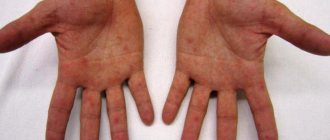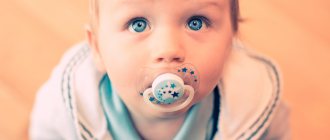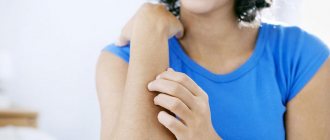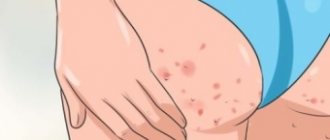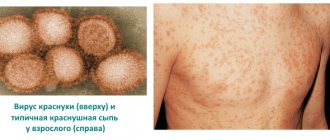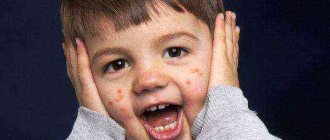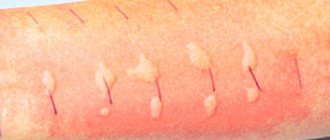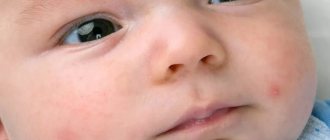Why do they appear?
In children of different ages, the causes of rashes on the butt also differ.
Therefore, it would be more correct to consider this symptom separately by age group.
In newborns
In newborns, rashes on the butt can be hormonal in nature.
Here, maternal hormones play a role, which enter the baby’s blood in the last weeks before birth.
The buttocks are not the only site where they appear; they are usually more or less evenly distributed throughout the body.
The rashes themselves do not cause any concern to the baby, and parents should not worry either.
These pimples will go away on their own, without any outside intervention.
Other causes of pimples on a baby’s buttocks may include:
- diaper dermatitis. It occurs due to skin irritation by the child’s natural secretions, the remains of which were not promptly removed from the surface of the skin. Urine and feces contain acids and ammonia, which damage the very delicate skin of the baby. The rashes look like spots that consist of small red pimples. The spots may become wet and cause a burning sensation in the baby, especially when a new portion of urine or feces gets on them;
- prickly heat. There is a strong belief that newborn babies are always cold. Yes, the mechanisms of thermoregulation at this age are still very imperfect, but many parents take this literally and try to wrap the baby warmer. The result of overheating can be prickly heat, which manifests itself in the form of red pimples, clusters of which are found in skin folds (in the groin, between the buttocks) and on the surface of the butt.
- allergic reactions. The factors that provoked such a reaction in the body could equally be nutrition, care products for the baby, and products for washing his linen and clothing. Sometimes a certain brand of diapers also causes allergies in the baby.
Photo
In children of the first years of life
This category includes the first 2 years of a child’s life.
At this age, many babies still use diapers, and not everyone can talk about their feelings (hot, wet, etc.).
Taking care of babies' skin still remains one of the main tasks of parents.
The causes of rashes on the buttocks can be:
- overheating remains a common factor causing rashes on the butt;
- insufficient care. Untimely cleansing of the child’s skin, lack of hygiene;
- manifestation of allergies. Food allergens or new skin care products and washing powder come first;
- synthetic clothing. Not only provokes overheating, but also disrupts metabolic processes in the upper layers of the skin;
- bacterial or fungal infection. Pimples on a child's bottom may appear due to infection with scabies, candidiasis, as well as childhood infectious diseases (scarlet fever, measles, rubella). In the latter case, the rash will be located all over the body. Typically, an infectious rash begins in the head, neck, and chest. On the legs and butt it appears last.
Ages 2 to 6 years
At the age of 2 years, the child matures noticeably.
Many children can already quite clearly signal the discomfort that has arisen. Diapers are losing their relevance, and with them prickly heat in this area of the body is much less common.
The causes of rashes on the buttocks in children aged 2 to 6 years can be:
- incorrectly chosen clothes. Narrow, tight, constricting clothing disrupts the respiration processes in skin cells. Synthetic underwear is also unacceptable for children;
Photo: manifestation of an allergic reaction
- allergic manifestations. Continue to be the most common cause of rashes;
- hygiene errors. At the age of 4 years, the child should already be taught to perform simple hygienic actions;
- insect bites. Besides mosquitoes, there are other types of insects that can leave marks on a baby's delicate skin;
- childhood infectious diseases. At the age of 3, many children begin to attend kindergartens or development centers. Due to the increased social group, the risk of infectious diseases also increases.
At 7 years and older
From the age of 7 years, the reasons listed above continue to matter.
But usually, rashes on the buttocks are rare, since the child can already explain the cause of the discomfort and even eliminate it independently in some cases (for example, take a shower, change underwear).
The peak of childhood infections also occurs at 4-5 years.
Of course, the risk of getting rubella, chickenpox and other diseases remains throughout life (if you don’t get them in childhood), but it is already lower than at an earlier age.
This situation continues until the onset of puberty, when rashes on the buttocks can be triggered by changing hormonal levels, dietary errors and other, more “adult” reasons.
What are the main causes of rashes?
Rashes are divided into three categories: allergic, contact and infectious. The causes of these diseases can be quite common mistakes by parents in observing simple hygiene standards or serious illnesses. However, there are not many sources for these reasons.
Sources of these reasons
Diapers . Rarely changing diapers almost always leads to this result. The baby's skin should remain dry at all times. Additionally, the rash may be the result of an allergic reaction to a brand of diaper.
Overheating . You should always carefully monitor the temperature and humidity levels of the room in which the child is located. For the same reason, skin rashes can appear not only in the buttocks area, but throughout the body.
Failure to comply with hygiene standards . Cleansing the surface of a child’s skin must be timely, because this can lead to more serious consequences.
Dermatitis . Dermatitis on a child’s bottom can occur due to untimely cleansing of the baby’s natural secretions, which were not removed from the surface of the skin in time. These contaminants damage the skin and cause discomfort or even pain when the irritation occurs again.
Allergy . Of course, this option is not excluded. Carefully monitor your child's reaction to food and body care products or clothing so that an allergic reaction does not occur on the child's bottom in the future. Allergic rashes spread not only on the buttocks, but, for example, on the legs or face of the child.
Skin injury . Tightening with an elastic band, rubbing with uncomfortable clothes.
Synthetic clothing . Baby clothes should always consist of natural fabrics. Failure to comply with this rule leads not only to overheating, but also to metabolic disorders of the skin.
Infectious diseases . If the rash appears on other parts of the body, it may be a sign of a bacterial disease. In this case, the best solution would be to consult a doctor.
Toxic erytherma . The spots may merge and have bubbles. But ordinary brilliant green can help here.
Fungal diseases usually appear as red spots with blisters and crusts.
Hemorrhagic rash
It is worth mentioning such an important rash as hemorrhagic rash. It spreads not only on the buttocks, but throughout the entire skin: on the arms, legs, etc. Such a rash is a signal of a dangerous disease - hemorrhagic vasculitis.
Treatment of this disease is impossible on your own - you must undergo it in the hospital, following the instructions of doctors, a hypoallergenic diet and strict bed rest. The disease can occur due to weakened immunity, excessive stress and emotional overload, hypothermia, allergies or the use of medications in large quantities.
What they look like
By the appearance of acne, you can determine the problem that caused it.
Of course, parents cannot always independently determine whether it is an allergic rash or prickly heat. But a specialist just needs to look at acne to understand what is causing it.
Reds
If the pimples on a baby's bottom are red, this may be a symptom of diaper dermatitis, prickly heat, and an allergic reaction.
The rashes, at first glance, are quite similar.
They can be distinguished by the following characteristics:
- With diaper dermatitis, small pimples are located in areas that in appearance resemble large red spots. This occurs due to skin irritation. Pimples may have watery contents that come to the surface and turn into crusts. When contacting urine, the child will experience an unpleasant feeling, a burning sensation. He will talk about it with worry, crying;
- With prickly heat, pimples look like separate elements. They do not merge with each other and the skin between them is not inflamed;
- allergic rashes are usually located symmetrically on the buttocks, that is, they will appear on both the left and right sides. Areas with the rash may be red, but they usually quickly become dry and begin to peel. If a child scratches these areas, cracks and abrasions may form on them, which increases the risk of bacterial infection.
Photo: red rash
Red pimples can also appear as a result of infectious diseases such as measles, rubella, but, as mentioned earlier, the rash is not the first place to appear on the buttocks.
So usually the disease can be diagnosed before the rash on the butt becomes noticeable.
White
Dermatologists usually call white pimples rashes without signs of inflammation and without purulent contents.
They usually have no content at all, representing so-called papules.
Typically, white pimples are not a serious symptom.
- They can appear due to insufficient hygiene if dead skin particles are not exfoliated in time.
- The same rashes can appear due to wearing synthetic underwear or hypothermia.
Therefore, there is no need to worry about them, but if the rash does not go away within 2 weeks, then you need to show the child to the doctor.
Purulent
Purulent are pimples with a white head.
They are usually inflamed, that is, the skin around the tip is red. The contents may be not only white, but also yellowish or greenish.
Photo: purulent rashes
In this case, parents need to worry.
Very often, purulent rashes are provoked by staphylococci (especially golden, the most dangerous of all varieties).
The most striking example is vesiculopustulosis - damage to the skin by this type of bacteria. The condition may become more complicated if the infection penetrates into the deeper layers of the skin or spreads through the blood throughout the body.
Squeezing out pustules or lack of treatment can contribute to such an unfavorable development of infection.
Watery
Watery pimples can be a manifestation of another disease that mainly occurs in newborns - pemphigus.
It is also caused by Staphylococcus aureus or Streptococcus.
- First, red spots appear, in place of which a transparent bubble forms.
- Then the liquid in it turns yellow and turns into pus.
Photo: watery rash
If such acne breaks out, you cannot do without medical help.
- Small watery blisters may be signs of dermatitis or allergic reactions.
- Chickenpox also manifests itself in the form of a blistering rash. But acne first appears in the upper part of the body and only then goes down.
A more clear idea of the types of acne on a child’s buttocks will be given by a photo with explanations.
But don’t rush to make a diagnosis yourself; entrust this matter to a specialist.
Why does a child develop pimples on his butt, how to treat them?
Children's skin is very delicate, so it is often exposed to irritants.
The rash is common and can appear at any time. Depending on the age of the child, the causes of rashes may vary. Sometimes this can be a signal of improper hygiene or the development of pathological processes in the body. To rule out a number of serious diseases, the child must be shown to a doctor.
A child has pimples on his butt - reasons
There are many factors that can lead to the appearance of rashes on children's skin. First of all, it is necessary to pay attention to the nature of the rash, the degree of damage and the age of the child.
In newborns
- One of the causes of pimples in newborns is diaper dermatitis. This disease is an inflammation of the skin in the buttock area. The cause of the development of dermatitis is considered to be poor hygiene and prolonged exposure to dirty diapers. ammonia contained in mole and feces irritates the baby’s delicate skin, which leads to rashes.
- A common cause of acne is an allergic reaction to care products (wipes, soap, diapers). In order to avoid allergies, it is advisable to choose products without fragrances and intended for children.
- Pimples around the anus may indicate a food allergy.
therefore, the diet should be reconsidered. - Staph infection is also a cause of the rash. it can appear not only on the child’s buttocks, but also on other mucous membranes.
- Another reason is climate.
the rash often appears due to inappropriate temperature in the room where the child is. If your baby sweats, rashes can appear on any part of the body.
in children of the first years of life
In the first place among the causes of rashes are allergies and poor hygiene. At this age, parents should actively monitor the baby’s health and instill in him knowledge about personal hygiene.
At the age of 1-2 years, the baby is taught to go to the potty, but it takes time until the child himself asks to go to the toilet. Parents need to change their baby's underwear on time to prevent rashes.
The first years of life involve a transition to a normal diet. Because of this, problems often arise with the child’s digestive system. rashes become a reaction to certain foods, so it is necessary to monitor the general condition of the baby and his stool.
Parents should be alerted to the presence in stool of:
- bleeding;
- mucus;
- white clots.
The presence of the above symptoms may indicate dysbacteriosis. If there is abdominal pain, loss of appetite and restlessness in the baby, then gastrointestinal diseases or helminth infection may develop.
Another cause is considered to be infectious diseases: scabies, candidiasis, scarlet fever, measles, rubella. If an infection occurs in the baby’s body, the rash affects not only the butt, but also other parts of the body.
if redness appears after going outside, then a possible cause is hypothermia. To protect yourself from the cold, you should choose the right clothing.
from 2 to 6 years
From the age of 3, a child is enrolled in a kindergarten where other children are, and the risk of contracting an infection increases accordingly. At this time, it is important to strengthen the baby’s immunity.
To avoid hypothermia, walks in the fresh air should take place for a set period of time; you should not sit on cold benches or other surfaces. The anus area is sensitive to low temperatures, so it is important to keep the baby's body warm.
To prevent rashes, you need to choose clothes made from natural fabrics. You should avoid synthetic fabrics that do not conduct air and do not allow the skin to breathe.
at this age, the rash appears due to poor personal hygiene, eating unwashed fruits and vegetables, as well as large amounts of sweets.
after 7 years and older
at an older age, in some cases the child can explain and eliminate the cause of the rash on his own (for example, change underwear, take a shower).
Infectious diseases are less common, since children by school age have a number of vaccinations that protect them. The older the child becomes, the easier it is for him to explain the area of discomfort, make a diagnosis accordingly and eliminate the rash.
The cause of the rash may be puberty, during which hormonal levels become disrupted. The peak of change in a child’s body occurs individually, so it is impossible to determine the exact age of maturation. It should be remembered that in modern children growth begins much earlier.
The next reason for a rash on the butt is stress and overexertion. The first time at school can be a real test for a child due to adaptation to the environment and a new team. doing homework, bad grades and separation from parents often upsets the baby, which can lead to health problems.
sudden changes in air temperature also cause rashes. the most dangerous period is autumn and spring, when the temperature outside changes throughout the day. Parents should monitor the child’s clothing, avoiding overheating and hypothermia.
Eating large amounts of sweets and fast food has an adverse effect on the condition of the child’s body, in particular the skin. As a result of metabolic disorders, the child may develop rashes on the buttocks.
types of acne in children on the buttocks
Depending on the type and appearance of acne, you can determine the cause of its appearance.
Reds
If red pimples appear in a child, they are diagnosed with:
- diaper dermatitis;
- heat rash;
- allergies.
In order to distinguish the cause of the rash, you should remember the main differences between the diseases.
- Diaper dermatitis is characterized by a rash of small pimples on various parts of the body. The red spots may have a watery content that turns into a crust over time. Dermatitis occurs due to improper hygiene and greatly worries the child. Because of the burning sensation, the baby becomes restless and often cries;
- with prickly heat, pimples are located on different parts of the body, without touching each other and without inflaming the skin;
- the allergy manifests itself immediately throughout the entire buttock area. After a few days, the pimples dry out and the skin begins to peel. If rashes are not treated promptly, wounds and cracks may form, which cause the development of bacteria.
Red pimples appear as a result of the development of infectious diseases:
It should be remembered that during infections, rashes on the buttocks appear last.
White
White pimples rarely contain pus or other substances, so they do not cause inflammation.
They appear as a result:
- poor hygiene;
- incorrectly selected clothes;
- hypothermia.
Such rashes do not threaten the child’s life and usually go away on their own. Parents should be alerted to a rash that does not go away within 2 weeks.
Purulent
Purulent pimples are easy to diagnose due to their white, yellow or green head. Often a rash indicates inflammation.
Such rashes should alert parents, since the appearance of pus indicates the presence of staphylococcus. In this case, it is important to start treatment on time, otherwise the infection may penetrate deep into the skin and blood.
Under no circumstances should pustules be crushed.
Watery
A watery rash often occurs in infants and is caused by staphylococcus or streptococcus bacteria.
The disease occurs in several stages:
- red spots appear, which after a few days turn into a bubble with transparent contents;
- The liquid turns yellow over time and turns into pus.
Watery pimples require immediate treatment. In some cases, bubbles may indicate the presence of dermatitis or allergies. When you have chickenpox, the rash spreads throughout the body from top to bottom.
What diseases cause acne on a child's bottom?
The appearance of a rash on a child’s buttocks may indicate the presence of infectious diseases:
- Rubella is characterized by the appearance of small pink rashes.
- Measles. Small bright red dots appear all over the body, first on the face and arms, then down to the butt.
- Scarlet fever. The symptoms are similar to measles. Red pimples, high fever and sore throat appear.
- Roseola. Characterized by the presence of high fever and pink pimples.
- Chickenpox. During illness, small blisters appear throughout the body, which eventually turn into crusts.
Infectious diseases very quickly affect a child’s body, so it is important to diagnose and begin treatment in a timely manner.
How to treat acne on the buttocks in children?
It should be remembered that the treatment of acne on the butt depends on the diagnosis and the age of the child. In any case, you should not self-medicate and squeeze out pimples. Complex therapy is often required, which includes the use of medications and personal hygiene.
Drug treatment
Medicines must be prescribed by a doctor. Vitamin complexes, as well as products high in calcium and magnesium, are often used.
To treat purulent pimples, zinc ointment or salicylic alcohol is prescribed. Children after one year of age are allowed to use medications.
“Zinerit” is used to treat acne on the butt. It is applied to clean skin 2 times a day. An analogue of “Zinerit” is “Skinoren”; it also fights purulent pimples well.
The drugs should not be used to treat children under 3 years of age.
Traditional methods
Traditional medicine for the treatment of acne on the butt allows the use of:
- chamomile;
- soda;
- oak bark;
- bay leaf;
- calendula;
- potassium permanganate.
Chamomile, calendula or oak bark should be mixed with boiling water. This decoction has anti-inflammatory and antiseptic effects. Use baking soda to treat babies with caution, as a large dose can dry out the skin.
Hygiene rules
To prevent acne from appearing on your baby’s bottom, you should follow these rules:
- change underwear and diapers in a timely manner;
- use natural products to wash your baby;
- infants are washed after each trip to the toilet;
- To wash children, use soft sponges and napkins so as not to irritate delicate skin;
- regularly moisturize your baby’s skin with creams;
- monitor the child's nutrition.
What to do if pimples itch?
Itching can be caused by:
- skin irritation;
- allergies;
- scabies.
The first thing to do is to prevent scratching your pimples. Your child's nails should be trimmed short to reduce the risk of skin damage.
The affected areas are covered with thick clothing. Before the doctor arrives, lotions made from green tea, mint or lemon balm will help reduce itching. Such tinctures should be used if the child does not have allergies.
With proper treatment, a rash on children's skin does not cause serious consequences. The main thing is to follow all the doctor’s recommendations and take preventive measures to prevent repeated reactions. It should be remembered that formations on the skin do not appear out of nowhere, so it is important to establish the cause of their appearance.
Source: //skindiary.ru/zabolevaniya/pryshhi/pryshhi-u-detej-na-yagodicax.html
What diseases cause acne on a child's bottom?
A number of infectious diseases have a rash as one of their symptoms. This rash can also be localized on the skin of the buttocks.
It does not always appear here at the very beginning of the disease, but parents still need to know what diseases they are at risk of encountering:
- Roseola, or three-day fever. This infection is manifested by a sharp increase in temperature, which lasts for 3 days. After its reduction, pink-red pimples appear on the body;
- scarlet fever. It appears as small red rashes, first in the upper part of the body, and only then on the butt. The appearance of the rash is preceded by a sore throat and an increase in temperature to very high levels;
- measles. The rashes associated with this disease are large and red. They can merge with each other. Associated symptoms are lacrimation and fever;
- rubella. The difference from measles is that the rash that appears is small, its color is rather pink and it is not prone to merging with each other;
Photo: watery rash with chickenpox
- chickenpox. It appears as a rash in the form of transparent blisters. Their contents gradually become cloudy and each element turns into a crust. The temperature decreases along with the cessation of new rashes.
All these diseases can be accompanied by signs of intoxication of the body - headache, nausea, weakness.
To treat them, it is necessary to call a doctor at home, as these infections are quickly transmitted by airborne droplets.
How to treat
Treatment methods for rashes depend on the reason why they appeared:
Photo: cream for treating rashes is selected depending on the cause of its appearance
- insect bites - use topical antipruritics (Psilo-balm, Fenistil gel, etc.), take measures to neutralize insects;
- prickly heat - treated with normal hygiene procedures and frequent air baths;
- allergic rashes - usually require not only eliminating the allergen, but also taking antihistamines, which are prescribed by a doctor;
- diaper dermatitis - more frequent changes of diapers or diapers, hygiene procedures after each case of urination or defecation, the use of protective and healing creams (for example, Bepanten);
- infectious diseases - treatment is prescribed by a doctor.
Folk remedies
Many rashes on the skin of the buttocks can be quickly cured using traditional methods.
This is especially true for prickly heat and diaper dermatitis.
Photo: decoctions of medicinal herbs can be added to a bathtub
- Decoctions of medicinal herbs help with them - chamomile, string, sage, birch buds. They can be added to baths, used for rubbing and compresses.
Photo: for allergies, it is useful to use a decoction of bay leaves
- For allergic rashes, an infusion of bay leaves will provide good help. Place a dozen leaves in a small saucepan, add 1 liter of water and boil over low heat for 15-20 minutes. Then cover with a lid and let cool. You can wipe the areas with rashes with this infusion several times a day, and also add it to your evening bath.
Photo: a bath with sea salt is useful for rashes in children over two years old
- A sea salt solution has a good effect on damaged skin. Take 5 tablespoons of salt per liter of warm water and dissolve it. Sea salt can be used for compresses, rubbing, and baths. It is used in children over 2 years of age.
How to treat a rash at home?
Irritation on the bottom of a newborn can lead to restless sleep for the baby and his parents, so it is worth starting treatment on time and preventing the spread of rashes on the child’s skin.
Folk remedies
If a rash does appear, then folk remedies will be your first aid. For example, a decoction of chamomile or birch buds will quickly help cope with prickly heat. They can be used for rubbing, baths and compresses.
To stop an allergic reaction, make a tincture of bay leaves: to do this, add ten leaves to one liter of water and boil for 15 to 20 minutes, then cover with a lid and let cool. If you have allergies, it won’t hurt to add sage infusion to the baths, which will help overcome the rash.
Raspberry decoction can be added to baths or used internally to eliminate severe diaper rash and redness.
Medicines
If treatment with folk remedies does not lead to the desired result, you need to turn to medications. For example, such as:
- Desitin. If the area of redness itches, Desitin will reduce inflammation and relieve itching. In addition to treating rashes, it can also be used as a diaper cream.
- Bepanten . A unique ointment that will help cope with a red rash on a baby’s bottom, peeling, dry skin, diaper rash or irritation.
- Drapolene. The cream disinfects and moisturizes the skin surface.
- Purelan. Softens affected skin, prevents the appearance of cracks, peeling and redness between the baby’s buttocks.
IMPORTANT TO REMEMBER
A rash in a two-year-old child can appear quite often and suddenly, especially in young children. The reasons for this can be completely different, and the treatment for each rash is different. However, there is no need to be scared. A timely visit to the doctor will help to cope with any problem and prescribe the correct treatment, if necessary.
Children's skin always reacts more sharply to various negative factors than adults. However, if you follow basic rules, troubles can be easily avoided.
Tags: rash About the author: Andrey Stepanovich
« Previous entry
What to do if you itch
Acne that appears on the buttocks can itch due to:
- skin irritation;
- allergic nature of rashes;
- infection with demodex (subcutaneous mite) or scabies.
Photo: if rashes appear on the body, the baby should be examined by a doctor
In this case, it is better to consult a doctor.
- Before visiting him, you should monitor your child so that he does not scratch his skin. To do this, first of all, you need to trim his nails and cover the part affected by pimples with thick clothing.
- Freshly brewed green tea, which should be used to wipe pimples, will help reduce itching. A decoction of mint or lemon balm will also be effective, of course, if the child is not allergic to these herbs.
Basic rules of hygiene
With the help of daily hygiene procedures, you can not only prevent the appearance of acne, but sometimes also cure the following:
Photo: daily hygiene procedures will effectively combat the appearance of rashes
- daily shower, wash off dirt with just water, use baby soap once or twice a week;
- When taking baths, do not rub children’s skin with washcloths; it is better to use cloth napkins or soft terry mittens;
- During the day, the child should take air baths at least 2-3 times a day, more often in hot weather;
- special protective creams are used under the diaper; you can use regular baby cream without fragrances;
- new foods are introduced into the baby’s diet gradually in small portions;
- washing children's clothes should be carried out using products specially designed for this purpose;
- the bottom layer of clothing on a child should always be made of cotton;
- wet diapers or nappies should be changed promptly.
Rashes on the butt in children are usually not very dangerous.
Most often, they indicate some errors in care or nutrition. But still, they cannot be ignored.
Any damage to the skin can cause complications, so when the first symptoms appear, measures should be taken immediately.
Video: “Rash in children - Doctor Komarovsky”
Acne is not only a cosmetic problem for children, but can also be quite painful. We are talking about acne in a rather piquant place - on the buttocks. Why children get pimples in such an inconvenient place and what to do, we will tell you in this material.
Causes
Pimples on the butt in children of different ages appear due to various reasons. In a newborn, they are usually associated with hormonal processes. A child in the neonatal period receives a large portion of maternal sex hormones, which cause blockage of the sebaceous glands and hair follicles, followed by their inflammation. In children in the first months of life, pimples on the butt appear rarely. Typically, acne in babies is localized on the head and face.
Children of primary preschool and school age may suffer from acne on the buttocks for other reasons. Clogged pores can occur due to poor hygiene. Dead epithelial cells usually slough off and remove themselves. But if a child suffers from excess production of sebaceous glands or has oily skin, then exfoliation may be difficult. Accumulated dead cells cause pore obstruction, inflammation develops with the addition of a bacterial infection.
The appearance of acne on a child’s bottom is also influenced by the child’s lifestyle. If physical activity is not enough, if the child spends most of his free time sitting, then the risk of various rashes on the “fifth point” increases.
It should be noted that the skin on the butt is not at all similar to the skin on other parts of the body. It is much drier; the glands in this part of the body produce less subcutaneous fat.
This means that the protection of the epidermis on the butt is reduced. Any aggressive external influence can lead to local inflammation - acne.
Hormonal imbalance quite often causes acne on the buttocks during adolescence. Under the influence of colossal doses of sex hormones that are synthesized in the body of a teenager, the sebaceous glands work more actively, and pores become clogged faster. Children love to sit on their butts. Moreover, they try to sit down everywhere - on the floor, in the sandbox. This often leads to the appearance of so-called cold pimples and acne associated with local hypothermia of the skin.
Pimples and blackheads on the buttocks can appear as a result of metabolic disorders. If a child eats incorrectly and unbalancedly, his diet contains a lot of fats and carbohydrates, then the secretory functions of the skin change, and the subcutaneous fat itself becomes thicker and more viscous, which leads to clogged pores.
Types of acne
There are several types of acne that can occur on the buttocks:
- Zhiroviki. These are white and yellow subcutaneous formations, not burdened by a purulent process.
- Papules. Dense reddish protruding nodules without signs of suppuration.
- Pustules. These are purulent acne.
Acne can also be localized, isolated, or diffuse—when the rash spreads over a large surface of the skin. Deep purulent pustules can become complicated and become boils. Superficial acne is rarely complicated by underlying inflammatory processes.
How to distinguish from a disease?
It is worth noting that acne and blisters on the butt can also appear due to certain diseases:
- Herpetic infection . The area of the buttocks, anus, and genitals is usually affected by the herpes virus type 2. Genital herpes appears as a small red rash with pronounced blisters filled not with pus, but with serous fluid. This infectious rash itches, itches, and causes severe pain to the child.
- Allergic reaction. With diaper dermatitis, little boys and girls may develop pimples under the diaper. They are caused by exposure to chemicals found in urine and feces. With other types of allergic dermatitis, the pimples will spread to other parts of the body, not just limited to the buttocks. An allergic rash differs from acne in that it does not have purulent “heads”; it looks like large red spots consisting of small red pimples without visible filling.
- Viral infectious disease. With chickenpox, roseola and other childhood diseases that manifest as skin rashes, the rash has a large area of distribution; not a single virus affects only the baby’s bottom. Other symptoms of the disease are also necessarily present - nausea, fever, muscle pain, respiratory manifestations - runny nose or cough.
- Avitaminosis. With a chronic lack of vitamins and microelements necessary for the normal growth and development of a child, pimples can appear in various parts of the body, the butt is no exception. This rash can be quite painful and is often complicated by a bacterial infection, which manifests itself in the gradual suppuration of papules and their transformation into pustules.
If you can’t figure out on your own what kind of pimple popped up on your child’s bottom, you should definitely consult a doctor so as not to look at the symptoms of a possible disease.
Treatment
It should be remembered that acne on the buttocks cannot be cured with baby powder and baby cream. These care products are good only for diaper rash, however, they make it much more difficult to treat acne. Also, pimples should not be squeezed. This will cause severe pain to the child and increase the likelihood of bacterial infection in the wound remaining after squeezing.
Pustules and rashes on the intimate part of the body require delicate and comprehensive treatment. First of all, your child should completely avoid wearing synthetic underwear. This is especially true for teenage girls who, in pursuit of fashion trends, wear tight synthetic panties and refuse to accept normal underwear made from natural fabrics. Panties, pajamas and bed linen must be made from natural fabrics.
For babies with the delicate problem of acne on the buttocks, you should buy only white cotton panties and T-shirts, without textile dyes, which can irritate the skin and increase the likelihood of inflammation. For infants, you should choose high-quality and hypoallergenic diapers.
With the permission of the pediatrician, the child should begin to be given vitamin complexes approved by age. To solve skin problems, an increased content of vitamins A, E, C, as well as calcium and magnesium is required. Your child’s diet should definitely include fresh fruits and vegetables, lean fish and meat, and dairy products. The ban includes baked goods made from yeast dough, sweets, fatty and fried foods, pickled foods, smoked fish and meat, butter, lard and all fast food without exception.
The child should move more. If he didn’t play sports before and didn’t go for walks often, it’s time to start visiting a skiing section, go skiing with the whole family on weekends, or, as a last resort, just take short leisurely walks around the house before going to bed.
You should not wash your child with a hard washcloth, rubbing his butt in the hope that all the pimples will go away. This only intensifies suppuration and contributes to the onset of a large-scale inflammatory process.
When bathing, you should avoid contact with acne with detergents; you should wash your butt with a soft sponge or by hand.
For painful purulent pimples on the buttocks, you can use zinc ointment and salicylic alcohol. Lightly wipe the affected area of skin with an alcohol solution, and lightly lubricate the pimples with ointment. This should not be done on children under one year of age; it is not advisable for them to apply medications to acne. Zinc ointment is used 1-2 times a day.
Among the drugs that show fairly quick and effective results for acne on the butt, one can note the cream "Zinerit" . It contains both zinc and an antibiotic. It should be applied to acne no more than 2 times a day, the skin should be clean. Typically, “Zinerit” is recommended for children with severe pustular skin lesions. Another drug that can be applied to acne is Skinoren .
These ointments should not be used on children under 3 years of age.
Dermatologists warn teenage girls against using various scrubs in the butt area; they should also not apply compresses or alcohol lotions. Despite the abundance of popular advice to “anoint with iodine so that everything goes away,” you should not use alcohol-based or alcohol-free antiseptics. Iodine and brilliant green are good remedies, but not for acne.
A child of any age who is not prone to allergies will benefit from a bath with a decoction of chamomile or string. Teenagers can add celandine and a decoction of birch leaves to the water. If a child visits a swimming pool where there is contact with chlorine, which is used to disinfect the water, then you should definitely take a shower after each workout, avoiding the prolonged presence of aggressive substances on the sensitive skin of the buttocks. Purulent pimples on the butt that have “burst”, as well as pimples whose integrity the child has violated, for example, by rubbing with clothes or scratching, can be sprinkled with Baneocin . This will have an antimicrobial effect and protect the wound from penetration of pathogens.
To learn about the possible causes of acne in children and what to do about them, watch the following video.
What to do if acne appears on a child’s bottom, and what are the causes of its occurrence? This question worries parents of both infants and older children. At each age, the causes of rashes may be different, so it is necessary to study this symptom depending on the age group.
Other types of rashes in newborns
It is imperative to take into account that a rash on the butt can be a harbinger of inflammation in other areas of the skin. The entire surface area of a child may be responsible for the same pathologies. It's just that sometimes pimples appear earlier in certain areas. You need to understand all types of diseases that can cause bum pimples so that you can prepare for any situation.
Experts often discuss this topical topic to a wide audience. Be sure to watch the video below, in which an experienced pediatrician shares recommendations for independently determining the type of rash and infant:
An equally pressing question is how to treat irritation on a child’s bottom. As mentioned, the main source of rash in the summer can be the diaper. The recommendations listed in the video below will help you quickly get rid of irritation and put your baby in order. They can be combined or used separately:
Acne in newborns and children of the first year of life
During the first weeks of a baby’s life, his body is still in close connection with the mother’s, so the pimples that appear on the butt of a newborn are explained by the presence of mother’s hormones in his blood, which got there before the baby was born. Such rashes usually do not bother him and go away after some time. In this case, parents should not worry about the fact that the baby has acne all over his butt.
Pimples on the butt of a baby also occur for other reasons:
- Diaper dermatitis, caused by skin irritation as a result of the baby’s natural secretions, traces of which were not removed in a timely manner. Acid and ammonia residues irritate the baby's delicate skin, leaving small red pimples grouped in spots on it. The inside of the pimples can be watery, and when fluid is released, they dry out and crust over. When new portions of urine and feces come into contact with them, the spots become wet, and the irritation intensifies, causing itching and a burning sensation in the baby.
- Heat rash caused by the desire of caring parents to wrap their baby warmer. By overheating the baby's skin with excessively warm clothes, they provoke the appearance of prickly heat (small red pimples) in the groin folds and on the buttocks. Children under one year of age should wear clothes only made from natural fabrics.
- Allergic reactions. In children under 1 year of age, any change in diet or usual hygiene products can provoke an allergic reaction on the skin in the form of small red pimples.
Causes of rashes and parental worries
Sometimes red rashes on the buttocks do not cause discomfort or other symptoms. This rash goes away on its own without any treatment. But there are reasons why red pimples appear on a child’s tender bottom.
Diaper dermatitis
This is an inflammation of limited skin areas, which is caused by exposure to physical, mechanical, chemical or microbial factors.
Diaper dermatitis appears for natural reasons, due to the release of sweat, which remains in the folds as a result of insufficient hygiene, especially in the first days of the baby’s life.
It is often observed when a wet diaper is not removed in a timely manner, because the urine may contain a high percentage of acidity. It damages the baby's delicate skin, resulting in irritation in the form of pimples.
Prickly heat
This is a skin irritation that develops due to increased sweating and slow evaporation of sweat.
Many parents think that little children are always cold - this is not entirely true. Indeed, the function of thermoregulation in children under one year of age is not fully formed, and most parents take this literally, dressing their children “in a hundred clothes.” As a result of constant overheating of a small body, prickly heat occurs, which manifests itself in small red rashes. Most of them are formed in the folds and on the surface of the buttocks.
Heat rash can be caused by poor quality personal hygiene products, poor nutrition, if the baby grows up on baby formula. In such situations, it is worth reviewing his diet and choosing other bathing products.
Allergy
An allergic reaction can develop to laundry detergents, synthetic clothing, baby food with a high content of starch and dyes, and various products. Some types of diapers can be irritants.
If an allergy develops, rashes may appear on other parts of the body. This problem can be inherited. Often allergic manifestations occur after introducing a new diet.
Acne in children 2-6 years old
As children grow older, they learn the rules of hygiene and can already tell their parents about any discomfort. At the same time, parents do not always choose the right clothes for their babies: they can be too tight, tight or made of synthetic fabrics. Such clothing prevents moisture evaporation and air access to the skin, causing redness and acne.
As with infants, the appearance of red pimples on a child's bottom can be caused by allergic reactions to the external environment or changes in diet.
At the age of 3, most children begin to attend preschool institutions, where there is a high risk of catching an infection and contracting one of the childhood diseases: measles, scarlet fever, rubella, chickenpox. In these cases, the rash appears first in the upper part of the body, gradually descending. The peak of childhood infectious diseases occurs at 4-5 years.
Acne and insect bites can cause acne, leaving red marks on the baby's bottom.
The main causes of rashes
The most common causes of various redness on children's buttocks are:
Infrequent diaper changes
If the baby stays in a diaper for a long time, this can cause diaper rash, inflammation, and a rash on the bottom. Also, a certain brand of diapers can cause a rash on a baby’s bottom.
Overheating
Keeping a baby in a room with a high level of humidity and a fairly high room temperature can cause rashes not only on the butt, but also on the baby’s face, arms, and legs. A child who is overheated may be capricious and lethargic. Therefore, you should take a closer look at the temperature in the room and try to ensure optimal humidity in the house.
Diaper dermatitis
It happens to newborns sometimes when they are swaddled. The baby's skin hardly breathes when the baby is tightly wrapped in a diaper. And since newborns often defecate, the risk of this type of rash increases.
Violation of hygiene rules
Rare washing, incorrect or untimely treatment of folds often lead to the appearance of various redness on the skin.
Allergic reaction and diathesis
A red rash that appears on the face, mouth, and bottom of babies indicates the presence of an allergic reaction to certain foods or other allergens (dust, animal dander, indoor plants). Often, a rash of allergic origin appears when the baby is bottle-fed or if complementary foods are introduced (new foods into the baby’s diet).
The listed reasons are typical, in most cases, for the occurrence of various rashes in children under one year of age. Basically, this difficulty, which appears as a result of the reasons described, is not a serious disorder and can be cured at home without visiting a doctor. But, if the rashes have pronounced redness, peel, pustules form, and body temperature rises, then you should consult a pediatrician.
The appearance of acne and their differences
All of the above reasons provoke the appearance of red pimples on the buttocks, but in dermatology there are several more types of white rashes. White pimples are not a symptom of any dangerous disease and occur due to non-compliance with hygiene rules, wearing underwear made of synthetic fibers or severe hypothermia. If they do not disappear within 10-12 days, it is recommended to consult a doctor.
The greatest danger is represented by purulent pimples on the butt, which indicate the presence of a staphylococcal infection in the child’s body. Externally, they look like pimples, the head of which is filled with white, yellow or greenish-gray contents. The appearance of such symptoms is a serious cause for concern, since the penetration of bacteria into the deeper subcutaneous layers is fraught with serious complications. You should absolutely not squeeze out pustules; you should immediately consult a doctor. Another type of disease that is very common in newborns is pemphigus, which is accompanied by the appearance of watery pimples, which are reddish transparent blisters that fill with pus over time. They can also be caused by a staph infection. In this case, calling a doctor is mandatory.
A watery, blistering rash may also be a sign of dermatitis or allergies. With chickenpox, a similar picture is observed, but, as a rule, pimples first appear on the face, back and chest.
How to treat watery pimples on a child’s body
It is important to understand that it is almost impossible to independently determine the true cause of the rash. To provide effective treatment, the problem must first be diagnosed. For this reason, you should consult a doctor.
Only an experienced doctor can give safe recommendations on how to get rid of vesicular pimples on the body; self-medication in this regard is strictly contraindicated.
Medicines
First of all, the doctor identifies the real cause of the rash, and only then prescribes a specific drug treatment.
During the treatment the following can be used:
- products that effectively fight various viruses (Aceclovir ointment or Panavir is prescribed against herpes);
- if the blisters that arise are the result of an allergic reaction of the body, then antihistamines may be prescribed. Also in this case, it is necessary to carry out not only internal treatment, but also external treatment, using ointments (most often the doctor prescribes Tavegil, Suprastin, Dezal);
- hormonal drugs for oral administration and in the form of ointments (Advantan, Elokom);
- to relieve the effect of burning and itching, you can use Panavir (gel);
- it is also necessary to ensure rapid healing of the blisters using zinc ointment or salicylic alcohol;
- if you need to get rid of scabies mites, it is best to use sulfur ointment.
In some cases, the surface of the bubbles can be moistened with a weak solution of brilliant green or potassium permanganate to remove pathogenic bacteria from the surface of the skin.
However, before the doctor arrives, it is not advisable to use brilliant green to treat areas of the skin affected by pimples. This will make it difficult to make a correct diagnosis based on visual examination.
Nutrition correction
During the period of breastfeeding, mother and child are one. In most cases, all intestinal disorders and emerging skin pathologies are associated with low-quality breast milk.
If watery formations appear on the baby’s skin, everything sweet, salty and spicy should be excluded from the mother’s diet. It would also be wise to give up fatty and fried foods, fast food, and processed foods. The consumption of berries and fruits also needs to be reduced.
For several days you need to adhere to a certain diet, which includes eating healthy foods:
- buckwheat porridge;
- leaf salads;
- lean meats;
- fish;
- green apples.
Remove allergen
Naturally, the type of allergen can only be identified after a visit to the doctor and a series of laboratory tests. But before that, the first thing you should do is change the baby’s clothes, remove all things made of synthetics, and replace the bedding.
Children's clothing should be washed with laundry soap or hypoallergenic washing powder. If the rash on the body is caused by allergic reactions, then most likely it will disappear soon.
Diseases that cause acne
Many infectious diseases are characterized by the appearance of a rash on the body, although it may not appear immediately. The most common childhood illnesses that cause a rash are:
- Roseola, or three-day fever. The symptom is a fever that lasts for three days, after which pink pimples appear on the body.
- Measles. It is characterized by bright red rashes that merge into large spots. There is a high temperature and lacrimation.
- Scarlet fever. Small red dotted pimples on the upper body, going down to the butt. Very high fever and sore throat.
- Rubella. It is characterized by a small pinkish rash that is not prone to merging into spots.
- Chickenpox. Transparent bubbles appear with gradually cloudy contents, which are released and harden in the form of a crust. The temperature persists throughout the period the rash appears.
All infectious diseases are usually accompanied by high fever, headache, weakness and nausea. These diseases spread very quickly, so in order to diagnose them and timely prescribe the necessary medications, you need to call a doctor at home.

